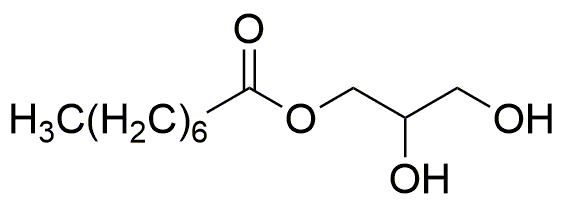Monocaprylin is widely utilized in research focused on:
- Food Industry: As an emulsifier and preservative, it enhances the texture and shelf life of various food products, making it ideal for baked goods and dairy items.
- Cosmetics and Personal Care: Its moisturizing properties make it a popular ingredient in creams and lotions, providing skin hydration and improving product stability.
- Pharmaceuticals: Used as a solubilizing agent for poorly soluble drugs, it helps improve bioavailability, allowing for more effective medication formulations.
- Animal Nutrition: Acts as a feed additive that promotes gut health and enhances nutrient absorption in livestock, contributing to better growth rates and overall health.
- Biotechnology: In cell culture applications, it serves as a surfactant that aids in the growth of cells, making it essential for research in tissue engineering and regenerative medicine.
Informations générales
Propriétés
Sécurité et réglementation
Applications
Monocaprylin is widely utilized in research focused on:
- Food Industry: As an emulsifier and preservative, it enhances the texture and shelf life of various food products, making it ideal for baked goods and dairy items.
- Cosmetics and Personal Care: Its moisturizing properties make it a popular ingredient in creams and lotions, providing skin hydration and improving product stability.
- Pharmaceuticals: Used as a solubilizing agent for poorly soluble drugs, it helps improve bioavailability, allowing for more effective medication formulations.
- Animal Nutrition: Acts as a feed additive that promotes gut health and enhances nutrient absorption in livestock, contributing to better growth rates and overall health.
- Biotechnology: In cell culture applications, it serves as a surfactant that aids in the growth of cells, making it essential for research in tissue engineering and regenerative medicine.
Documents
Fiches de données de sécurité (FDS)
La FDS fournit des informations de sécurité complètes sur la manipulation, le stockage et l’élimination du produit.
Spécifications du produit (PS)
Le PS fournit une description complète des propriétés du produit, notamment sa composition chimique, son état physique, sa pureté et les exigences de stockage. Il détaille également les plages de qualité acceptables et les applications prévues du produit.
Certificats d'analyse (COA)
Recherchez des certificats d'analyse (COA) en saisissant le numéro de lot du produit. Les numéros de lot et de lot se trouvent sur l'étiquette d'un produit, après les mots « Lot » ou « Lot de fabrication ».
Numéro de catalogue
Numéro de lot/série
Certificats d'origine (COO)
Ce certificat d'exploitation confirme le pays dans lequel le produit a été fabriqué, et détaille également les matériaux et composants utilisés et s'il est issu de sources naturelles, synthétiques ou autres sources spécifiques. Ce certificat peut être requis pour les douanes, le commerce et la conformité réglementaire.
Numéro de catalogue
Numéro de lot/série
Fiches de données de sécurité (FDS)
La FDS fournit des informations de sécurité complètes sur la manipulation, le stockage et l’élimination du produit.
DownloadSpécifications du produit (PS)
Le PS fournit une description complète des propriétés du produit, notamment sa composition chimique, son état physique, sa pureté et les exigences de stockage. Il détaille également les plages de qualité acceptables et les applications prévues du produit.
DownloadCertificats d'analyse (COA)
Recherchez des certificats d'analyse (COA) en saisissant le numéro de lot du produit. Les numéros de lot et de lot se trouvent sur l'étiquette d'un produit, après les mots « Lot » ou « Lot de fabrication ».
Numéro de catalogue
Numéro de lot/série
Certificats d'origine (COO)
Ce certificat d'exploitation confirme le pays dans lequel le produit a été fabriqué, et détaille également les matériaux et composants utilisés et s'il est issu de sources naturelles, synthétiques ou autres sources spécifiques. Ce certificat peut être requis pour les douanes, le commerce et la conformité réglementaire.

